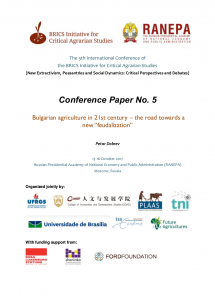Bulgarian agriculture in 21st century – the road towards a new “feudalization”
In the beginning of 20th century Bulgaria was among those countries in Europe that had the highest number of parceled out land with hundreds of thousands of small land owners toiling at their land at the brink of survival.

After 1944, Bulgarian agriculture underwent the typical for Eastern Europe model of collectivization and centralization. The agrarian reform of 1992, that was implemented by one of the first neoliberal governments in the country brought about new realities for Bulgarian agriculture. Today, 4% of agricultural enterprises manage more than 85% of all the land in Bulgaria; they are the recipients of the majority of European Union’s subsidies and practically are feudalizing the desolated Bulgarian village. How did all this happen?